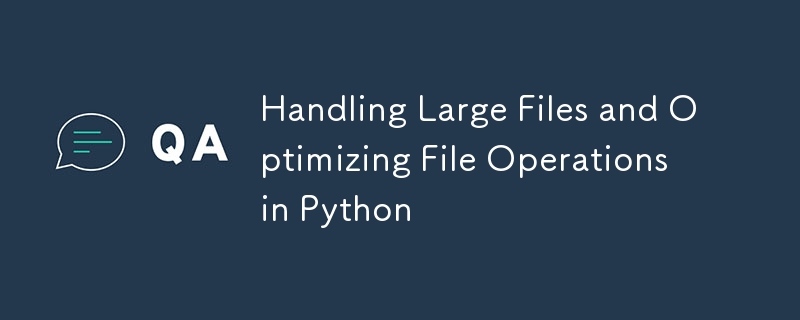ホームページ >バックエンド開発 >Python チュートリアル >Python での大きなファイルの処理とファイル操作の最適化
Python での大きなファイルの処理とファイル操作の最適化
- Barbara Streisandオリジナル
- 2024-09-24 16:18:32912ブラウズ

このブログ シリーズでは、Python でファイルを処理する方法について、基本から始めて徐々に高度なテクニックに進んでいきます。
このシリーズを終えるまでに、Python でのファイル操作を深く理解し、ファイルに保存されているデータを効率的に管理および操作できるようになります。
このシリーズは 5 つの投稿で構成され、各投稿は前の投稿の知識に基づいています。
- Python でのファイル処理の概要: ファイルの読み取りと書き込み
- さまざまなファイル モードとファイル タイプを使用する
- (この投稿) Python での大きなファイルの処理とファイル操作
- コンテキスト マネージャーと例外処理を使用した堅牢なファイル操作
- 高度なファイル操作: CSV、JSON、バイナリ ファイルの操作
Python プロジェクトが成長するにつれて、メモリに同時にロードするのが難しい大きなファイルを扱う場合があります。
大きなファイルを効率的に処理することは、特にデータ処理タスク、ログ ファイル、または数ギガバイトになるデータセットを扱う場合、パフォーマンスにとって非常に重要です。
このブログ投稿では、Python で大きなファイルの読み取り、書き込み、処理を行い、アプリケーションの応答性と効率性を維持するための戦略を検討します。
大きなファイルに関する課題
大きなファイルを扱う場合、次のような問題が発生する可能性があります。
- メモリ使用量: 大きなファイル全体をメモリにロードすると、大量のリソースが消費され、パフォーマンスが低下したり、プログラムがクラッシュしたりする可能性があります。
- パフォーマンス: 最適化されていない場合、大きなファイルの操作が遅くなり、処理時間の増加につながる可能性があります。
- スケーラビリティ: ファイル サイズが大きくなるにつれて、アプリケーションの効率を維持するためにスケーラブルなソリューションの必要性がより重要になります。
これらの課題に対処するには、パフォーマンスや安定性を犠牲にすることなく大きなファイルを操作できる戦略が必要です。
大きなファイルを効率的に読み取る
大きなファイルを処理する最良の方法の 1 つは、ファイル全体をメモリにロードするのではなく、ファイルを小さなチャンクに分けて読み取ることです。
Python は、これを実現するためのいくつかのテクニックを提供します。
ループを使用してファイルを 1 行ずつ読み取る
ファイルを 1 行ずつ読み取ることは、大きなテキスト ファイルを処理する最もメモリ効率の高い方法の 1 つです。
このアプローチでは、各行が読み取られるたびに処理されるため、事実上あらゆるサイズのファイルを操作できます。
# Open the file in read mode
with open('large_file.txt', 'r') as file:
# Read and process the file line by line
for line in file:
# Process the line (e.g., print, store, or analyze)
print(line.strip())
この例では、for ループを使用してファイルを 1 行ずつ読み取ります。
strip() メソッドは、改行文字を含む先頭または末尾の空白を削除します。
この方法は、各行が個別のレコードを表すログ ファイルまたはデータセットの処理に最適です。
固定サイズのチャンクの読み取り
場合によっては、ファイルを 1 行ずつではなく固定サイズのチャンクで読み取りたい場合があります。
これは、バイナリ ファイルを操作する場合、またはデータのブロックでファイルを処理する必要がある場合に役立ちます。
# Define the chunk size
chunk_size = 1024 # 1 KB
# Open the file in read mode
with open('large_file.txt', 'r') as file:
# Read the file in chunks
while True:
chunk = file.read(chunk_size)
if not chunk:
break
# Process the chunk (e.g., print or store)
print(chunk)
この例では、1 KB のチャンク サイズを指定し、そのサイズのチャンクでファイルを読み取ります。
while ループは、読み取るデータがなくなる (チャンクが空になる) まで読み取りを続けます。
この方法は、大きなバイナリ ファイルを処理する場合、または特定のバイト範囲を操作する必要がある場合に特に便利です。
大きなファイルを効率的に書き込む
読み取りと同様に、大きなファイルを効率的に書き込むことはパフォーマンスにとって非常に重要です。
データをチャンクまたはバッチで書き込むと、メモリの問題を回避し、操作の速度を向上させることができます。
データをチャンクに書き込む
大量のデータをファイルに書き込む場合、特にバイナリ データを操作する場合や大きなテキスト ファイルを生成する場合は、1 行ずつではなくチャンクに分けて書き込む方が効率的です。
data = ["Line 1\n", "Line 2\n", "Line 3\n"] * 1000000 # Example large data
# Open the file in write mode
with open('large_output_file.txt', 'w') as file:
for i in range(0, len(data), 1000):
# Write 1000 lines at a time
file.writelines(data[i:i+1000])
この例では、大量の行リストを生成し、1000 行ずつまとめてファイルに書き込みます。
このアプローチは、各行を個別に記述するよりも高速でメモリ効率が高くなります。
ファイル操作の最適化
データの効率的な読み取りと書き込みに加えて、大きなファイルをより効果的に処理するために使用できる最適化手法が他にもいくつかあります。
ファイルナビゲーションにseek()とtell()を使用する
Python の Seek() 関数と Tell() 関数を使用すると、コンテンツ全体を読まなくてもファイル内を移動できます。
これは、大きなファイルの特定の部分にスキップしたり、特定の時点から操作を再開したりする場合に特に便利です。
- seek(offset, whence): Moves the file cursor to a specific position. The offset is the number of bytes to move, and whence determines the reference point (beginning, current position, or end).
- tell(): Returns the current position of the file cursor.
Example: Navigating a File with seek() and tell()# Open the file in read mode
with open('large_file.txt', 'r') as file:
# Move the cursor 100 bytes from the start of the file
file.seek(100)
# Read and print the next line
line = file.readline()
print(line)
# Get the current cursor position
position = file.tell()
print(f"Current position: {position}")
In this example, we move the cursor 100 bytes into the file using seek() and then read the next line.
The tell() function returns the cursor's current position, allowing you to track where you are in the file.
Using memoryview for Large Binary Files
For handling large binary files, Python’s memoryview object allows you to work with slices of a binary file without loading the entire file into memory.
This is particularly useful when you need to modify or analyze large binary files.
Example: Using memoryview with Binary Files# Open a binary file in read mode
with open('large_binary_file.bin', 'rb') as file:
# Read the entire file into a bytes object
data = file.read()
# Create a memoryview object
mem_view = memoryview(data)
# Access a slice of the binary data
slice_data = mem_view[0:100]
# Process the slice (e.g., analyze or modify)
print(slice_data)
In this example, we read a binary file into a bytes object and create a memoryview object to access a specific slice of the data.
This allows you to work with large files more efficiently by minimizing memory usage.
Conclusion
Handling large files in Python doesn’t have to be a daunting task.
By reading and writing files in chunks, optimizing file navigation with seek() and tell(), and using tools like memoryview, you can efficiently manage even the largest files without running into performance issues.
In the next post, we’ll discuss how to make your file operations more robust by using context managers and exception handling.
These techniques will help ensure that your file-handling code is both efficient and reliable, even in the face of unexpected errors.
以上がPython での大きなファイルの処理とファイル操作の最適化の詳細内容です。詳細については、PHP 中国語 Web サイトの他の関連記事を参照してください。

